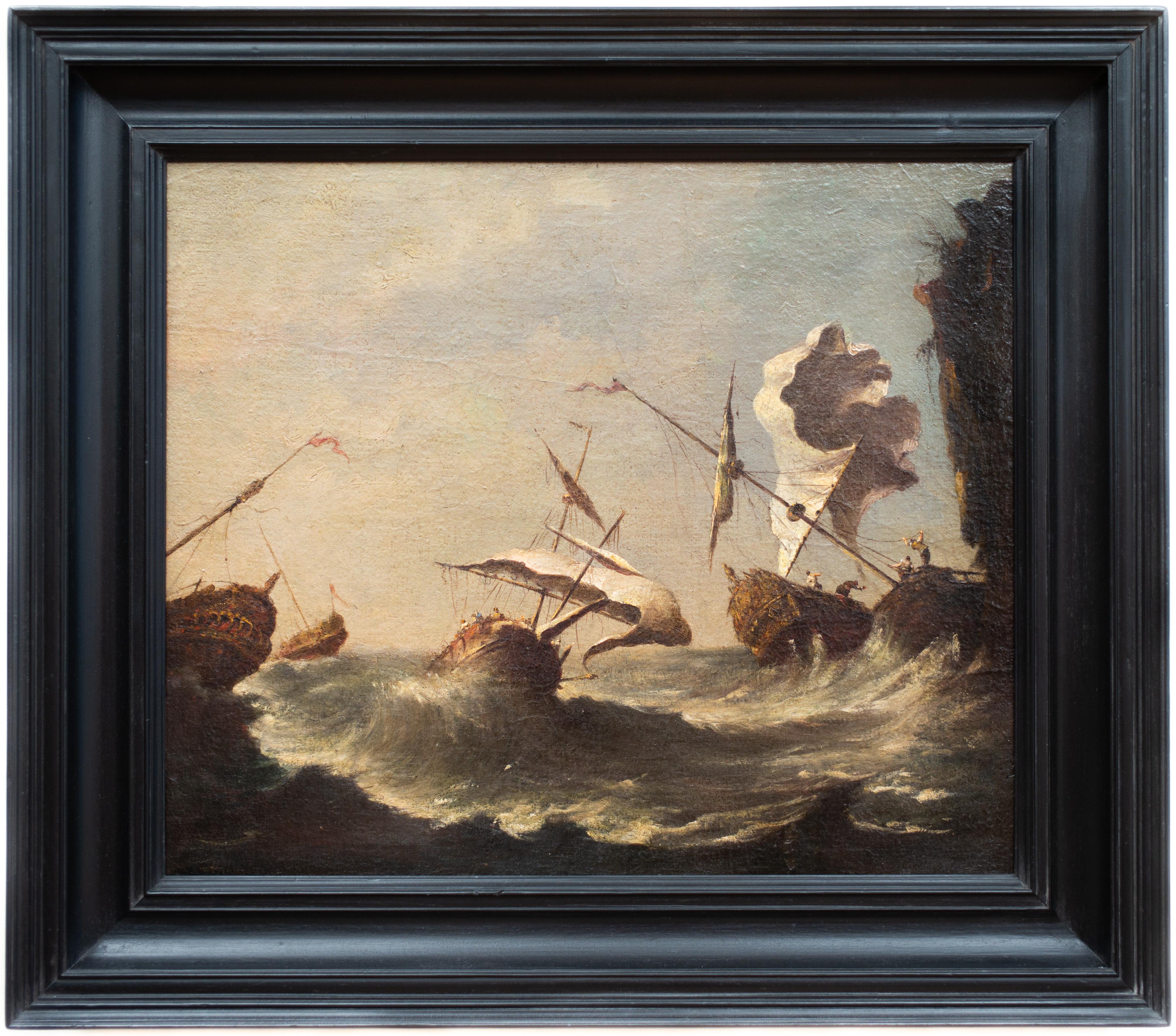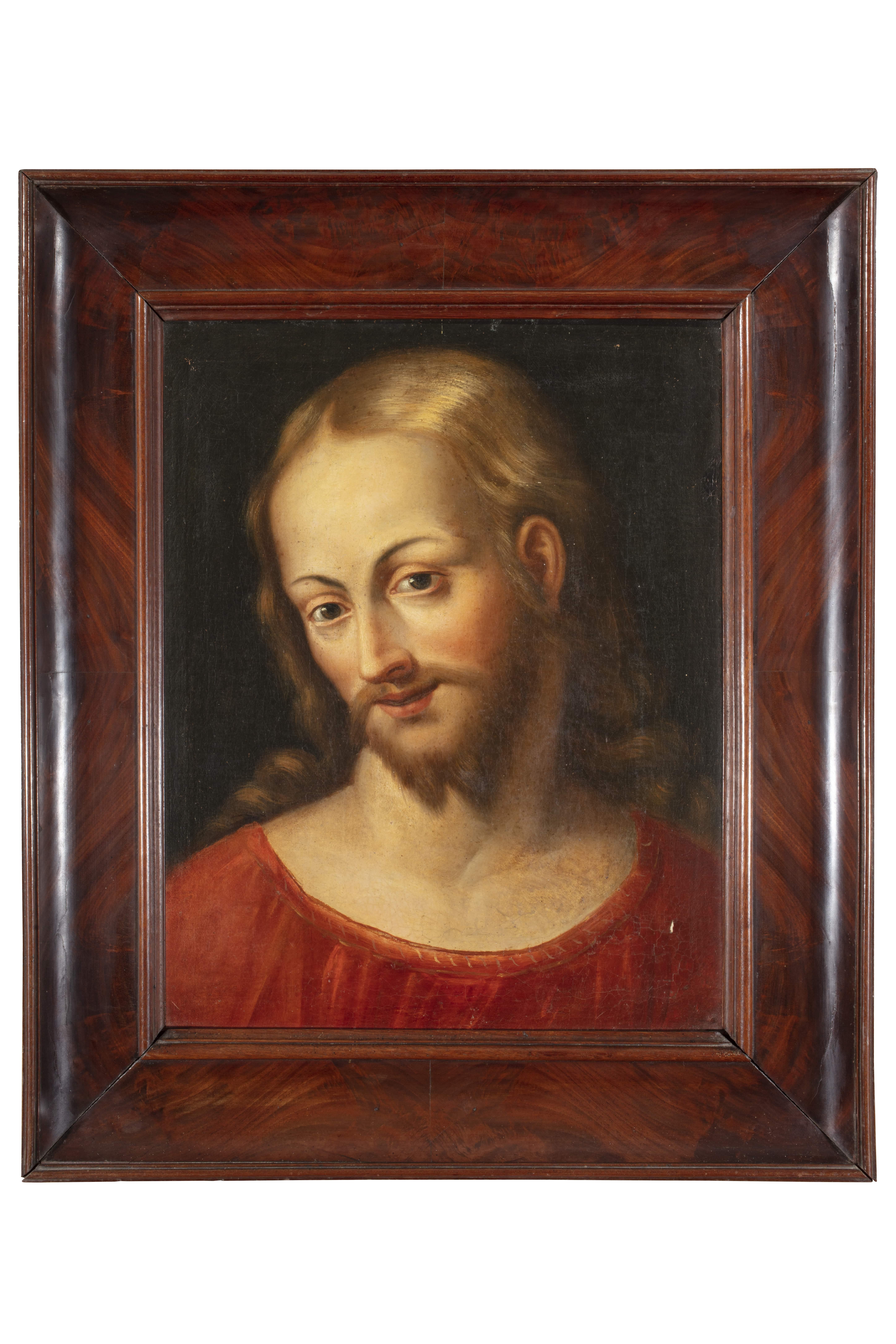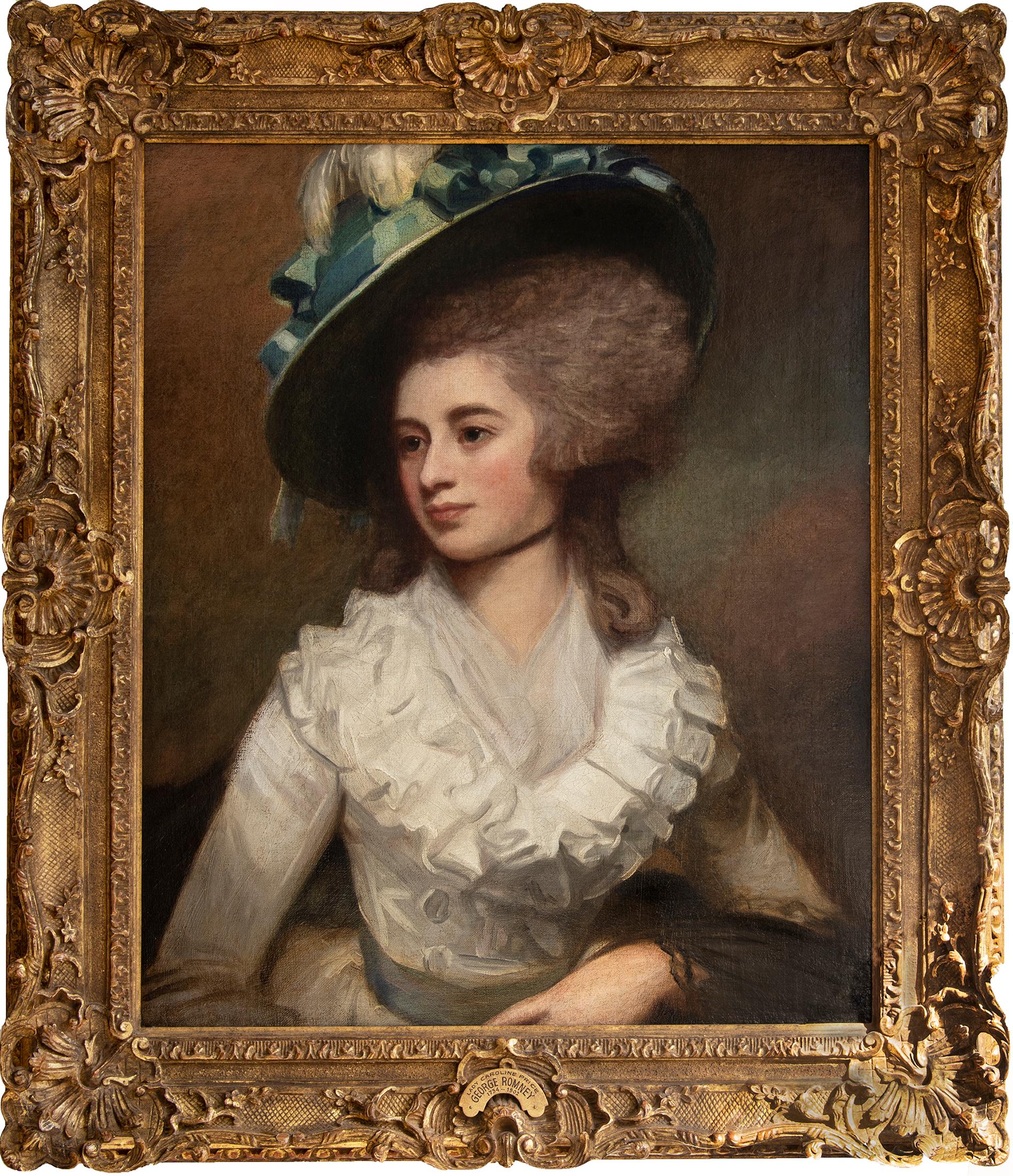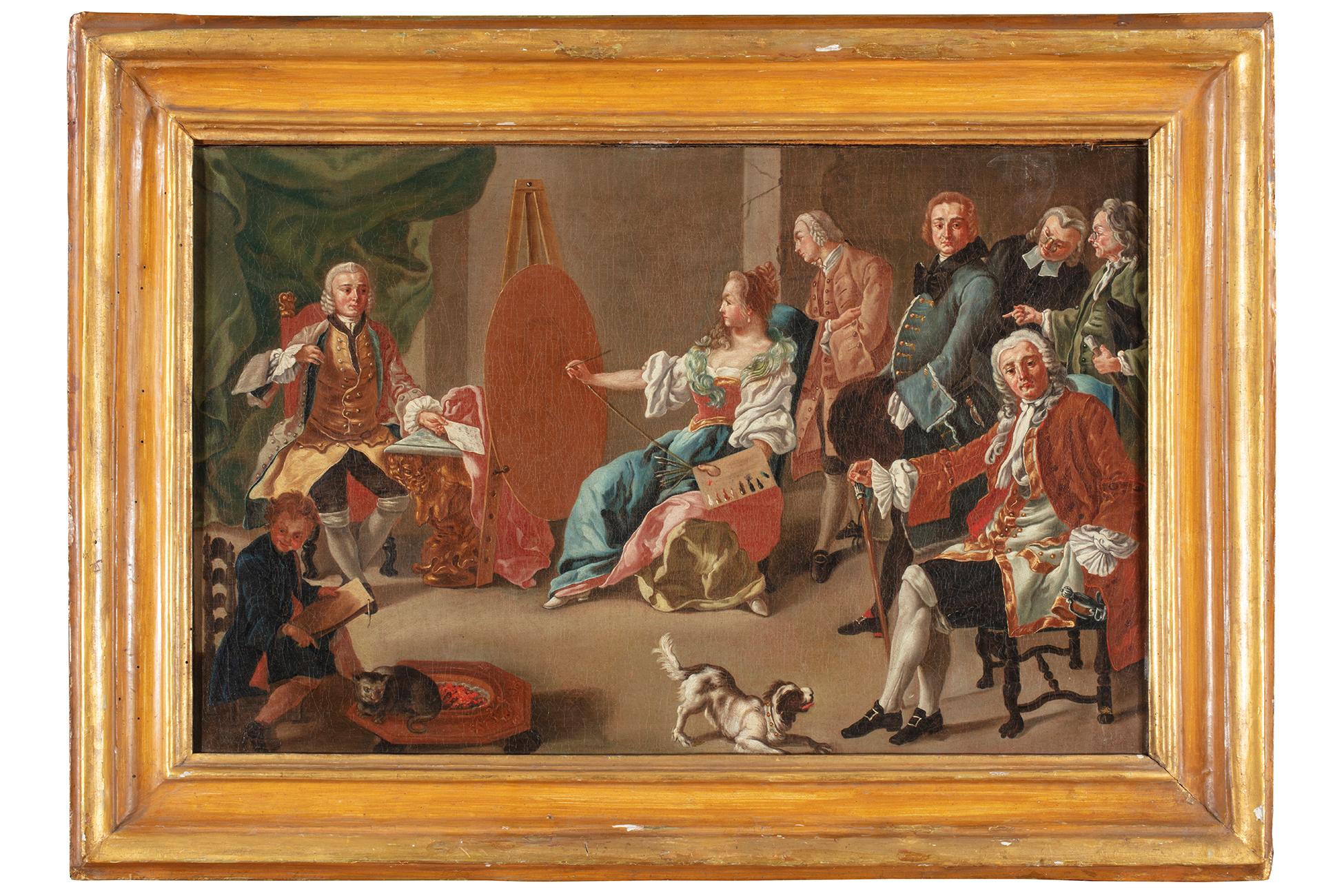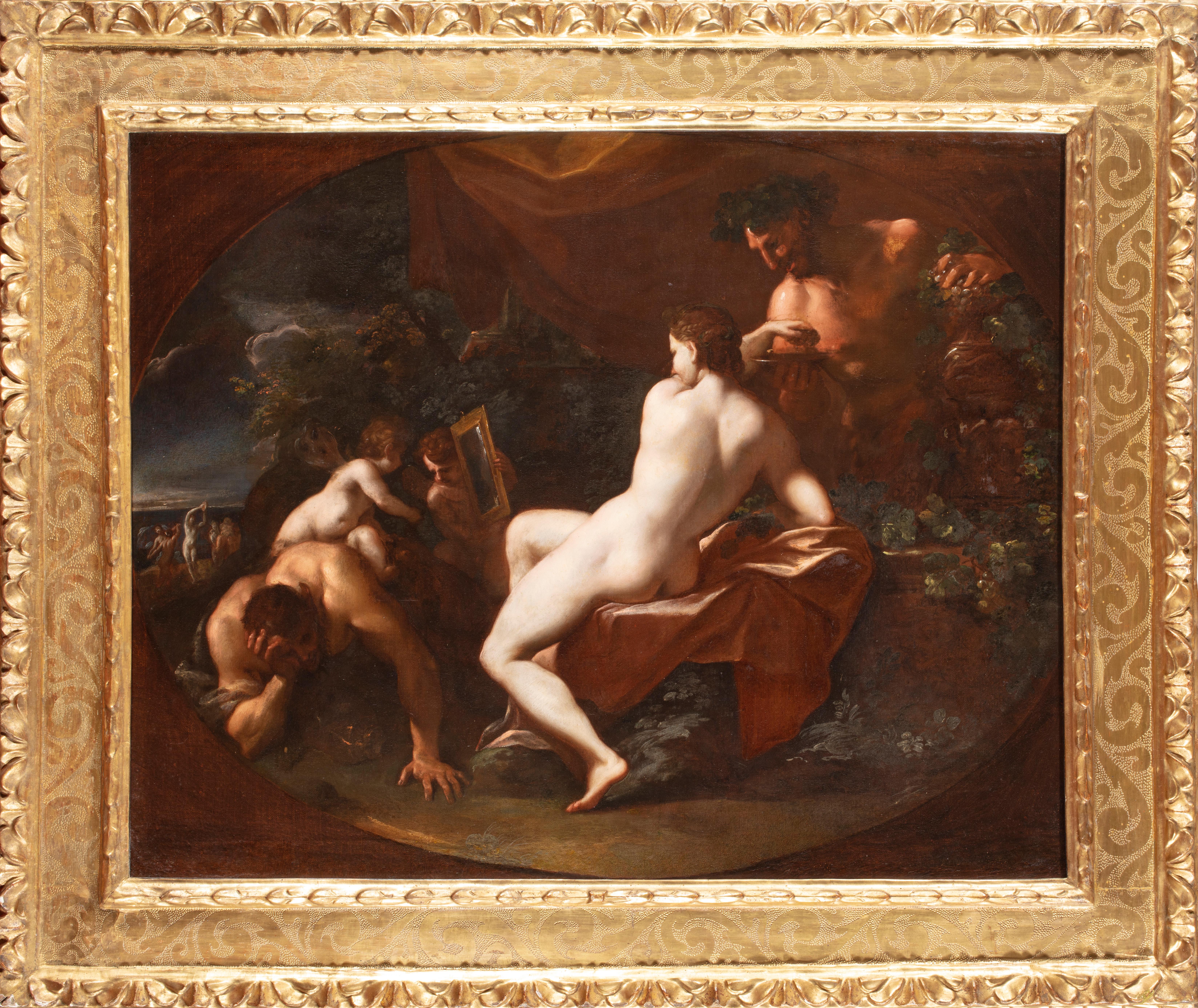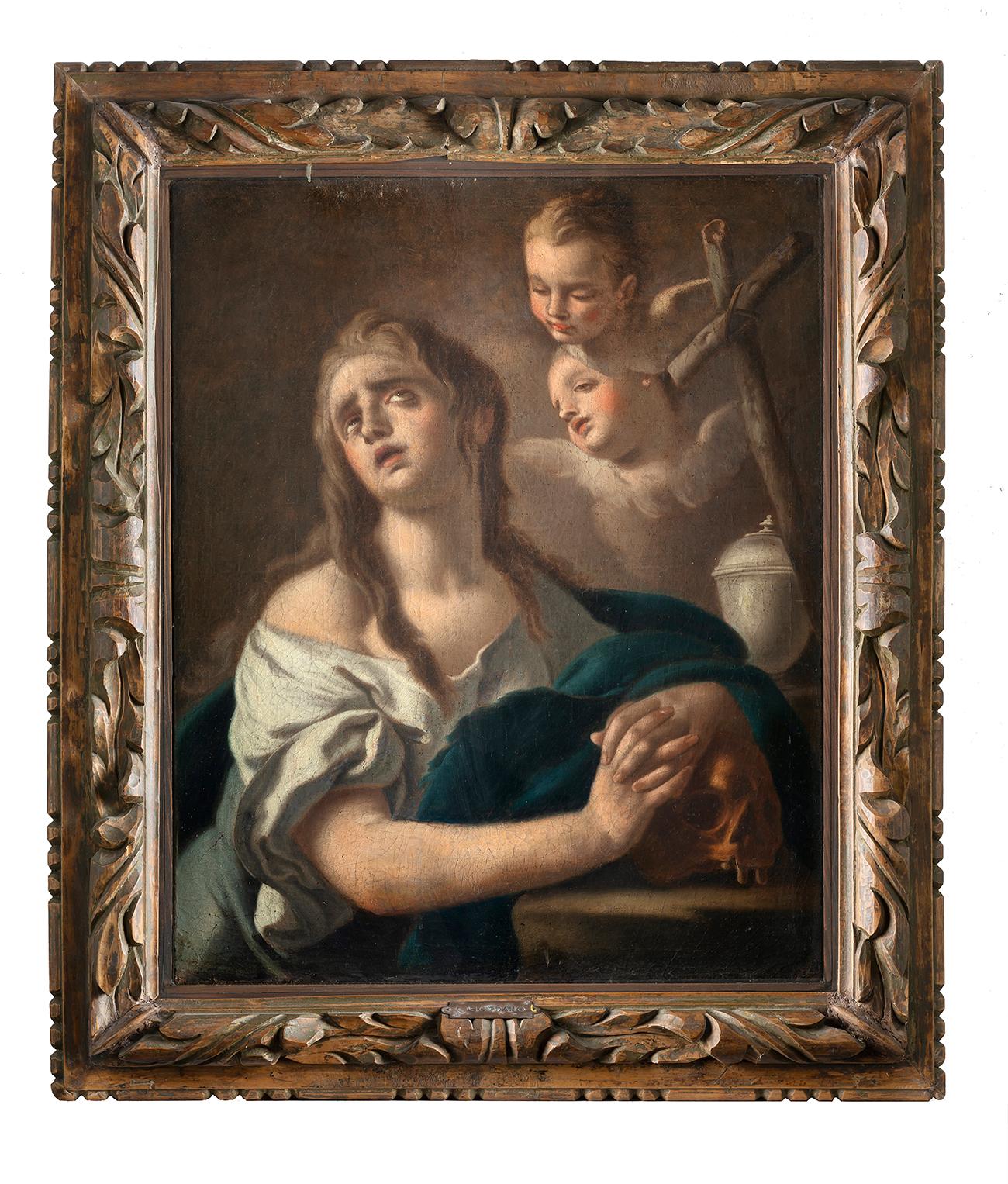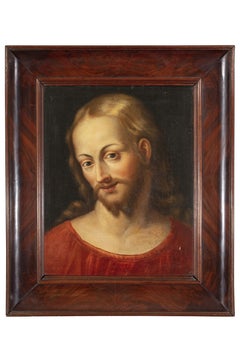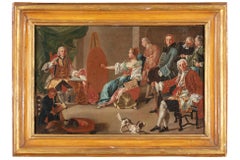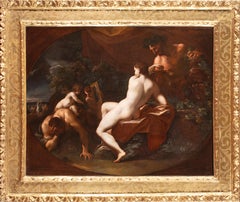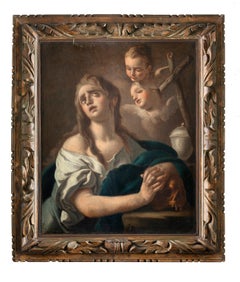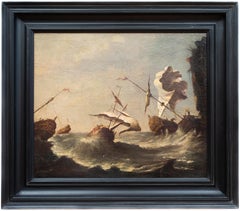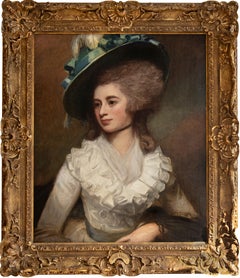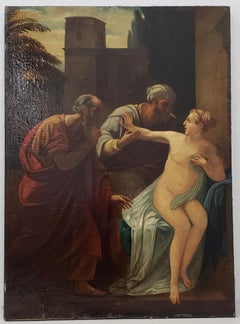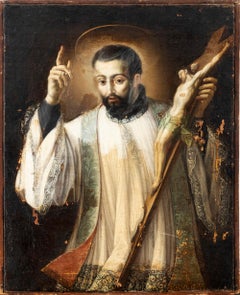Items Similar to 17th Century by Bartolomeo Guidobono Bacchanal with Maenads, Satyrs and Nymphs
Want more images or videos?
Request additional images or videos from the seller
1 of 12
Bartolomeo Guidobono (Savona, Italy, 1654 - Torino, Italy, 1709)17th Century by Bartolomeo Guidobono Bacchanal with Maenads, Satyrs and Nymphs17th Century
17th Century
About the Item
Bartolomeo Guidobono (Savona, Italy, 1654 - Turin, Italy, 1709)
Title: Bacchanal with Maenads, Satyrs and Nymphs
Medium: Oil on canvas
Dimensions: without frame 120 x 110 cm - with frame 136 x 125 x 5 cm
With wooden frame
Expertise by Anna Orlando, Professor and art historian
Publications: Uomini e Dei. Il '600 genovese dei collezionisti, curated by Anna Orlando, Sagep Editori, Genova, 2016, pp. 112, 113; Barocco spaziale - Dialoghi di luce, forma, colore fra pittura barocca e spazialismo, exhibition catalogue curated by Susanna Gualazzini, Fabio Obertelli, Carlo Scagnelli, (Piacenza, 8 December 2021 - 6 February 2022), Galleria Biffi Arte, Piacenza, pp. 24-25, 40-41, 101.
This exquisite canvas by Italian painter Bartolomeo Guidobono (Savona, Italy, 1654 - Turin, Italy, 1709) is an example of Baroque style but with hints of Rococo aesthetics. The painting is set in the half-light of a serene night, and it depicts a female figure at centre stage gently reclining, whose pale almost pearly skin and sensual body captivate the viewer. At the woman's feet is a pair of putti that seem to be lacing and entwining a sock of flowers. Flower buds are also found in the woman's hairstyles. The young woman is surrounded by various characters, including maenads, the female followers of Dionysus, satyrs and nymphs. The figure at the top, towering above the other characters in the scene is Bacchus, also known as Dionysus, the Greek god of wine inebriation, fertility and theatre. He is pointing his index finger towards the crown of stars in the sky, while his gaze is directed at Ariadne. In this work the artist plays on asymmetries and the apparent disorder of the scene depicted is recomposed by the overall vision of the painting.
- Creator:Bartolomeo Guidobono (Savona, Italy, 1654 - Torino, Italy, 1709) (1654 - 1709, Italian)
- Creation Year:17th Century
- Dimensions:Height: 47.25 in (120 cm)Width: 43.31 in (110 cm)Depth: 1.97 in (5 cm)
- More Editions & Sizes:Without frame cm. 120 x 110 - with frame 136 x 125 x 5 cmPrice: $56,647
- Medium:
- Movement & Style:
- Period:
- Condition:
- Gallery Location:Milano, IT
- Reference Number:1stDibs: LU1701214556592
About the Seller
5.0
Vetted Professional Seller
Every seller passes strict standards for authenticity and reliability
Established in 1964
1stDibs seller since 2021
Typical response time: 1 hour
- ShippingRetrieving quote...Shipping from: Milano, Italy
- Return Policy
Authenticity Guarantee
In the unlikely event there’s an issue with an item’s authenticity, contact us within 1 year for a full refund. DetailsMoney-Back Guarantee
If your item is not as described, is damaged in transit, or does not arrive, contact us within 7 days for a full refund. Details24-Hour Cancellation
You have a 24-hour grace period in which to reconsider your purchase, with no questions asked.Vetted Professional Sellers
Our world-class sellers must adhere to strict standards for service and quality, maintaining the integrity of our listings.Price-Match Guarantee
If you find that a seller listed the same item for a lower price elsewhere, we’ll match it.Trusted Global Delivery
Our best-in-class carrier network provides specialized shipping options worldwide, including custom delivery.More From This Seller
View All16th Century by Bernardino Detti Face of Christ Oil on Canvas
Located in Milano, Lombardia
Bernardino Detti (Pistoia, Italy, 1498 - 1572)
Title: Face of Christ
Medium: Oil on canvas
Dimensions: without frame 41 x 32 cm - with frame 47 x 55.5 cm
Antique box frame made of solid wood and walnut burl.
Publications: unpublished
The painting by Bernardino Detti (1498 - 1572) depicts the face of Jesus...
Category
16th Century Old Masters Figurative Paintings
Materials
Canvas, Oil
18th Century by Giuseppe Bonito The Painter's Studio or Allegory of Painting
Located in Milano, Lombardia
Giuseppe Bonito (Castellammare di Stabia, Italy, 1707 - Naples, Italy, 1789)
Title: The Painter's Studio or Allegory of Painting
Medium: Oil on canvas
...
Category
Mid-18th Century Old Masters Figurative Paintings
Materials
Canvas, Oil
17th Century By Domenico Maria Canuti Toilet of Venus with Cupids and Satyrs
Located in Milano, Lombardia
Domenico Maria Canuti (Bologna 1626 - 1684)
Title: Toilet of Venus with Cupids and Satyrs
Medium: Oil on canvas
Dimensions: without frame 79 x 98 cm - ...
Category
Late 17th Century Old Masters Figurative Paintings
Materials
Canvas, Cotton Canvas, Oil
18th Century by Pietro Bardellino Mary Magdalene Painting Oil on Canvas
By Pietro Bardellino
Located in Milano, Lombardia
Pietro Bardellino (Naples, Italy, 1731 – 1806)
Title: Mary Magdalene
Medium: Oil on canvas
Dimensions: without frame 75 x 60 cm – with frame 97 x 82 cm
Antique shaped and carved wood...
Category
Mid-18th Century Old Masters Portrait Paintings
Materials
Oil, Canvas
17th Century By Gian Giacomo Barbelli Paradise and Purgatory Oil on Canvas
Located in Milano, Lombardia
Already been in Koelliker collection (no. inv. LK0431)
Publications:
- C. Alpini, Ritratto di Gian Giacomo Barbelli nel IV centenario della nascita, in “Insula Fulcheria”, XXXIV, ...
Category
17th Century Old Masters Figurative Paintings
Materials
Canvas, Oil
17th Century by Juan Alfonso Abril Head of St Paul Painting Oil on Canvas
Located in Milano, Lombardia
Juan Alfonso Abril (active in the 17th century in Valladolid, Spain)
Title: Head of Saint Paul
Medium: Oil on canvas
Dimensions: without frame 48.5 x 62 ...
Category
Early 17th Century Old Masters Figurative Paintings
Materials
Oil, Canvas
You May Also Like
Shipping in Stormy Waters, Attributed to Italian Artist Francesco Guardi
By Francesco Guardi
Located in Stockholm, SE
The splendour of the tragic sea
Francesco Guardi and maritime painting in Venetian art
No Venetian painter was a stranger to the sea. After all, Venice was not only one of the most prominent ports of the Mediterranean, but indeed a city literally submerged in the ocean from time to time. Curiously however, the famous Venetian school of painting showed little interest in maritime motifs, favouring scenes from the iconic architecture of the city rather than seascapes. That is why this painting is a particularly interesting window into not only the painter Francesco Guardi himself – but to the significance of the element of water in art history, in absence as well as in the centre of attention.
Whether it be calm, sunny days with stunning views of the palaces alongside the canals of Venice or – more rarely – stormy shipwrecking tragedies at sea, water as a unifying element is integral to the works of painter Francesco Guardi (1712–1793). During his lifetime, Venetian art saw many of its greatest triumphs with names like Tiepolo or Canaletto gaining international recognition and firmly establishing Venice as one of the most vibrant artistic communities of Europe. While the city itself already in the 18th century was something of an early tourist spot where aristocrats and high society visited on their grand tour or travels, the artists too contributed to the fame and their work spread the image of Venice as the city of romance and leisure to an international audience, many of whom could never visit in person.
Still today, the iconic image of Venice with its whimsical array of palaces, churches and other historic buildings is much influenced by these artists, many of whom have stood the test of time like very well and remain some of the most beloved in all of art history. It was not primarily subtility, intellectual meanings or moral ideals that the Venetian art tried to capture; instead it was the sheer vibrancy of life and the fast-paced city with crumbling palaces and festive people that made this atmosphere so special. Of course, Venice could count painters in most genres among its residents, from portraiture to religious motifs, history painting and much else. Still, it is the Vedutas and views of the city that seems to have etched itself into our memory more than anything else, not least in the tradition of Canaletto who was perhaps the undisputed master of all Venetian painters.
Born into his profession, Francesco lived and breathed painting all his life. His father, the painter Domenico Guardi (1678–1716) died when Francesco was just a small child, yet both he and his brothers Niccolò and Gian Antonio continued in their fathers’ footsteps. The Guardi family belonged to the nobility and originated from the mountainous area of Trentino, not far from the Alps. The brothers worked together on more challenging commissions and supported each other in the manner typical of family workshops or networks of artists. Their sister Maria Cecilia married no other than the artist Giovanni Battista Tiepolo himself, linking the family to the most renowned Venetian name of the time. During almost a decade, Guardi worked in the studio of Michele Giovanni Marieschi, sometimes simply known as Michiel, a painted similar in both style and motif. Canaletto is, however, the artist Guardi is most often compared to since they shared a mutual fascination for depicting the architecture and cityscape of Venice.
During the course of his career, Guardi tried his hand in many different genres. He was as swift in painting landscapes, Vedutas of Venice, sacred motifs, interiors and architectural compositions as he was in a number of other motifs. His style is typical of the Venetian school but also distinct and personal once we look a little closer. There is an absolute certainty in the composition, the choice of which sometimes feels like that of a carefully calculated photograph – yet it is also very painterly, in the best sense of the word: fluid, bold, sensitive and full of character. The brushwork is rapid, intense, seemingly careless and extraordinarily minute at the same time; fresh and planned in a very enjoyable mixture. His interiors often capture the breath-taking spacious glamour of the palaces and all their exquisite decor. He usually constructed the motif through remarkably simple, almost spontaneous yet intuitively precise strokes and shapes. The result was a festive, high-spirited atmospheric quality, far away from the sterile and exact likeness that other painters fell victim to when trying to copy Canaletto.
The painting here has nothing of the city of Venice in it. On the contrary, we seem to be transported far away into the solitary ocean, with no architecture, nothing to hold on to – only the roaring sea and the dangerous cliffs upon which the ships are just moments away from being crushed upon. It is a maritime composition evoking both Flemish and Italian precursors, in the proud tradition of maritime painting that for centuries formed a crucial part of our visual culture.
This genre of painting is today curiously overlooked, compared to how esteemed and meaningful it was when our relationship to the sea was far more natural than it is today. When both people and goods travelled by water, and many nations and cities – Venice among them – depended entirely on sea fare, the existential connection to the ocean was much more natural and integrated into the imagination. The schools and traditions of maritime art are as manifold as there are countries connected to the sea, and all reflect the need to process the dangers and wonders of the ocean.
It could symbolize opportunity, the exciting prospects of a new countries and adventures, prospering trade, beautiful scenery as well as war and tragedy, loss of life, danger and doom. To say that water is ambivalent in nature is an understatement, and these many layers were something that artists explored in the most wondrous ways. Perhaps it takes a bit more time for the modern eye to identify the different nuances and qualities of historic maritime paintings, they may on first impression seem hard to differentiate from each other. But when allowing these motifs to unfold and tell stories of the sea in both fiction and reality – or somewhere in between – we are awarded with an understanding of how the oceans truly built our world.
In Guardi’s interpretation, we see an almost theatrically arranged shipwrecking scene. No less than five ships are depicted right in the moment of utter disaster. Caught in a violent storm, the waves have driven them to a shore of sharp cliffs and if not swallowed by the waves, crushing against the cliffs seems to be the only outcome. The large wooden ships are impressively decorated with elaborate sculpture, and in fact relics already during Guardi’s lifetime. They are in fact typical of Dutch and Flemish 17th century ships, giving us a clue to where he got the inspiration from. Guardi must have seen examples of Flemish maritime art, that made him curious about these particular motifs. One is reminded of Flemish painters like Willem van de Velde and Ludolf Backhuysen, and this very painting has indeed been mistakenly attributed to Matthieu van Plattenberg...
Category
18th Century Old Masters Landscape Paintings
Materials
Canvas, Oil
$46,421 Sale Price
32% Off
Free Shipping
Portrait of Lady Caroline Price
By George Romney
Located in Miami, FL
DESCRIPTION: Perhaps the best Romney in private hands. If Vogue Magazine existed in the late 18th century, this image of Lady Caroline Price would be ...
Category
1970s Old Masters Portrait Paintings
Materials
Oil, Canvas
Mid 19th Century "Susanna And The Elders" After The Old Master by Martinelli
Located in San Francisco, CA
Outstanding Mid 19th century old master "Susanna and the Elders" after Martinelli
Brilliant old master painting of Susanna and the Elders.
Original oil on canvas. Dimensions 26.5" ...
Category
Mid-19th Century Old Masters Nude Paintings
Materials
Oil, Canvas
$1,950 Sale Price
58% Off
San Francisco Javier
Located in Miami, FL
Colonial School, Mexico, XVIII Century
"San Francisco Javier"
Oil on canvas
18 x 14 in.
Category
18th Century Old Masters Figurative Paintings
Materials
Canvas, Oil
$8,000
18th Century Neoclassical Oil Painting of the Trojan War: Briseis & Achilles
By James Thornhill
Located in London, GB
James Thornhill (1674-1735)
Oil on canvas
12 x 14 inches;
16 ½ x 18 ½ in. Inc. frame
The subject matter and inclusion of herms on both sides shows the influence of Louis...
Category
Early 18th Century Old Masters Figurative Paintings
Materials
Oil, Canvas
18th century oil painting English portrait of a gent in armor, wearing a wig
By studio of Sir Godfrey Kneller
Located in Woodbury, CT
Outstanding early 18th century English portrait of James Bellevue.
The portrait was always believed to be the work of Sir Godfrey Kneller who was known to have painted James Bellevu...
Category
Early 1700s Old Masters Portrait Paintings
Materials
Oil, Canvas
$7,960 Sale Price
20% Off
Free Shipping
Recently Viewed
View AllMore Ways To Browse
Wooden Art Italian
Italian Baroque Art
Antique Satyr
Greek God Art
8 Feet Paintings
Italian Oil Painting Pair
Woman Wine
Italian Rococo Painting
Italian Theatre Light
Lace Figure
Paintings Of Putti
Wine 17th
17th Century Putti
Italian Oil Painting Wine
Baroque Style Putti
Oil Pairing 17th
Barocco Style
Satyr And Nymph
